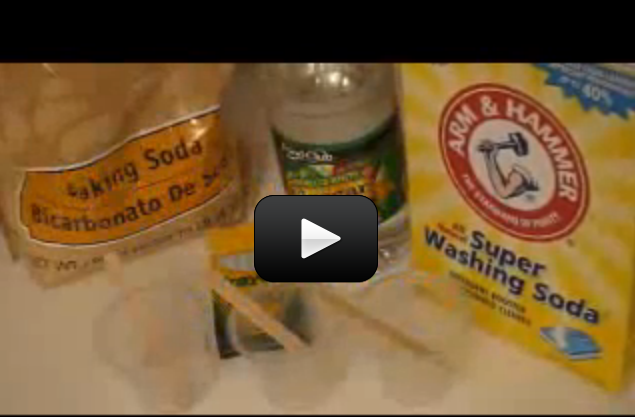You can use this as real ink by using it BEFORE you combine them together like this: dip a toothpick into the first solution (sodium ferrocyanide solution) and with the tip write onto a sheet of paper.
While the writing is drying, dip a piece of paper towel int other solution (ferric ammonium sulfate solution) and gently blot along where you wrote on the paper… and the color appears as blue ink. You can make your secret message disappear by wiping a paper towel dipped in a sodium carbonate solution.
You can also grow purple, gold, and red crystals with these chemicals… we’ll show you how!
Materials:
- sodium ferrocyanide
- ferric ammonium sulfate
- 2 test tubes
- distilled water
- goggles and gloves
- water


No, unfortunately not. It’s just a demo to show it’s the color of ink. It’s a really old demo, this one was done back in the 1950s when inks were really only one or two colors.
Can you use this as ink?
By the way, is our ferric ammonium sulfate solution and sodium ferrocyanide solution combo supposed to result in a dark blue liquid with dark blue sludge? Ours did. (We actually used potassium ferrocyanide to substitute the sodium ferrocyanide)
The Short kids
Is there a name for the product of our ferric ammonium sulfate solution and potassium ferrocyanide solution mix? We did this experiment with our cousin, and we had a great time while learning a lot!
Thanks Aurora,
The Short kids
Yes – I am sorry that the manufacturer keeps changing what they include in the C3000 box. Instead of tossing out the old videos I created and making new ones (which is a lot to keep up with, especially with this set), I decided to keep them and just add more as we go along so you could pick and choose the ones you wanted to do. 🙂
Thanks for this. I too was wondering why we didn’t have the chemicals we needed, because we bought the big C3000 set and thought we ought to be covered. This list of alternate ideas above is helpful.
Hi Kim,
Gosh – I am so sorry! Which items did you find that were missing? I can have my team scan the unit and create an updated list, but if you have something specific you’d like me to look at I can do that also. Again, my apologies – shop lists are updated with every new experiment that comes out.
Is there an updated shopping list for Unit 8? I bought all that was listed, and then some, and it seems like we keep having to skip an experiment here or there, because we are missing an item….I want to have everything ready for the whole Unit so that when we come to the experiment we can complete it. Please direct me to a new shopping list if there is one, thank you-
It’s actually in a kit that is purchased separately which is listed on the shopping list for Unit 8 under Chemical Kinetics.
Hmmm…. What kit is sodium ferrocyanide found in? I bought the Mastery program and am going through the book. I just came on here to ask where to buy it, however I’m not sure what Unit this experiment is in to help me find the shopping list for it. Thanks!
The only place I’ve seen it sold outside of the kit listed in the shopping list is here.
Do you know where I can get sodium ferrocyanide?
Try again? Seems to be working now.
woops, I’m having trouble getting the whole video to download, too
Hmmm… seems like they’ve switched MORE chemicals since we first looked over this set! Ok, here’s the deal – it doesn’t matter whether you use the sodium or potassium salt as it is the ferrocyanide ion that combines with the iron to produce the color. And yes, either salt will produce lethal HCN under certain chemical conditions, so be sure to keep acid away from it!
In fact, there’s a whole slew of chemicals that will produce ‘invisible inks’, such as:
* Phenolphthalein, commonly used as a pH indicator, turns pink in the presence of a base such as sodium carbonate.
* Vinegar, is revealed by red cabbage water. Vinegar contains acetic acid that affects the pH indicator in red cabbage water. Vinegar may also be developed by heat, as above.
* Ammonia, developed by red cabbage water.
* Copper sulfate, developed by sodium iodide, sodium carbonate ammonium hydroxide or potassium ferricyanide.
* Lead(II) nitrate, developed by sodium iodide.
* Iron sulfate, developed by sodium carbonate or potassium ferricyanate.
* Cobalt chloride, developed by potassium ferricyanide.
* Iron sulfate, developed by sodium sulfide.
* Starch, developed by iodine solution which turns starch dark blue and the paper light blue.
* Lemon juice, developed by iodine solution (ink turns white, paper turns light blue).
* Sodium chloride (common table salt), developed by silver nitrate (be careful with this chemical, as it’s highly toxic).
You can also use stuff from the fridge! The following are developed by the addition of heat (like a hair dryer) – just be careful not to scorch the paper when you’re developing it:
* Cola drink
* Honey solution
* Lemon, apple, orange or onion juice
* Milk
* Soap water
* Sugar solution
* Vinegar (wine works also, but get adult help for this)
* Cobalt chloride, which turns blue when heated and becomes invisible again after a while (if not overly heated)
Can we use potassium ferrocyanide in place of sodium ferrocyanide?
Sidney in SC
Whoops! The video didn’t upload fully. Sorry about that! I’ve got a new version uploading right now, so check back soon. Thanks for the tip! 🙂
Is the rest of the video on another screen? Thanks!
Was this video cut off?